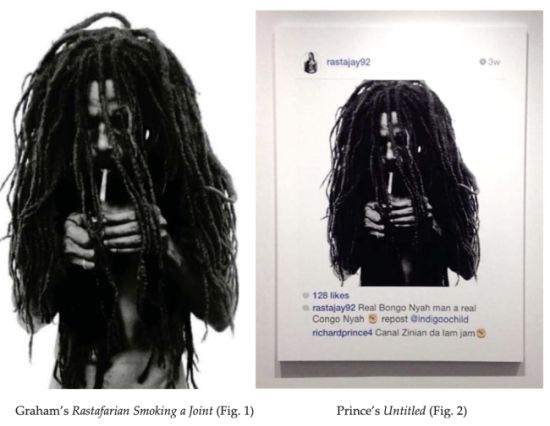An advertiser includes an infringing image in an advertising campaign. (It has been known to happen.) The copyright owner sues, seeking the profits earned by the advertiser during the run of the campaign. (This happens too.) How do you determine the extent to which, if at all, the advertiser's profits from the sale of the advertised goods were attributable to the infringing ad campaign?
This very question was raised in the long-running copyright litigation between photographer Donald Graham and artist Richard Prince. In 2014, Prince created and exhibited New Portraits, a series consisting of37 original works (the "Original Works"). In one of the works, Untitled (Portrait of Rastajay92), Prince incorporated without permission Graham's photograph Rastafarian Smoking a Joint. These are the two works at issue:

The litigants have been at it for coming up on a decade. Twice the district court rejected Prince's arguments that his use of Graham's photo was protected, as a matter of law, under the fair use doctrine. (See Graham v. Prince, 265 F. Supp. 3d 366 (S.D.N.Y. 2017) and Graham v. Prince, No. 15-CV-10160 (SHS), 2023 WL 3383029 (S.D.N.Y. May 11, 2023).) The case is headed for a trial, if it doesn't settle.
The latest opinion in this saga involves Graham's claims against the Gagosian Gallery (which represents Prince) and its owner Larry Gagosian. For five weeks in the fall of 2014, the gallery exhibited the Original Works, all of which were sold before the exhibition even opened, with Mr. Gagosian himself snagging Rastajay92 for his personal collection. Prince also produced and sold through the gallery a second set of 37 New Portraits works (the "Secondary Works"), as well as three custom New Portraits works that were offered to specific collectors (the "Specialty Works"). The Secondary Works sold out by the eighth day of the exhibition, and the final Specialty Work was claimed not long after the exhibition closed.
Graham sued to recover the profits earned by the Gagosian Gallery from the sales of the 36 Original Works (excluding Rastajay92), the 37 Secondary Works, and the three Specialty Works (collectively, the "Other Works"), even though the Other Works did not infringe upon Graham's copyright. Graham's theory was that buyers of the Other Works were influenced in their purchasing decisions when they saw the allegedly infringing Rastajay92 in advertising for the New Portraits series; because of this, Graham argued, the commissions earned by the gallery on those sales were attributable to the infringement.
The gallery and Mr. Gagosian moved for summary judgment on these claims, and District Judge Sidney H. Stein (SDNY) granted the motion.
Section 504 of the Copyright Act permits a copyright owner "to recover the actual damages suffered by him or her as a result of the infringement, and any profits of the infringer that are attributable to the infringement and are not taken into account in computing the actual damages" (emphasis added). In some circumstances, determining whether an infringer's profits are "attributable to the infringement" is straightforward. For example, if an infringer copies and sells the plaintiff's copyrighted work in its entirety (e.g., a street vendor who sells pirated copies of movie screenplays without authorization), then it is clear that the infringer's profits were attributable to the infringement. However, when (like in this case) the copyrighted work is used (without permission) to advertise goods, but is not incorporated in the goods themselves, measuring whether, and to what extent, the profits earned from the sale of those goods are "attributed to the infringement" presents challenges.
Although "modern cases more frequently deny profits earned from advertising that incorporates infringing copyrighted material," courts will buck this trend where the evidence shows that "the infringing work contributed to an increase in value of, or increase in decisions to buy, the non-infringing products" (citations omitted and cleaned up). In this case, did the Other Works sell like hotcakes because of the gallery's advertising efforts or for other reasons? Surely many (perhaps most) clients chose a specific portrait because it spoke to them in some way. Others may have been excited by the idea of owning an original work by a well-known and controversial artist. Connoisseurs may have wanted a work by Richard Prince to round out their collections. Wall Street types may have viewed a purchase as a good investment. So many buyers, so many potential motivations. And when you take into consideration the if-you-have-to-ask-you-can't-afford-it prices commanded by the Other Works, was it plausible that these sophisticated buyers made their purchases because they saw an ad?
Judge Stein held that Graham had failed to meet his initial burden of demonstrating a causal nexus between the alleged infringement and the gallery's profits from the sale of the Other Works. At the outset, the court noted that the gallery's promotional use of images of Rastajay92 was limited. Graham proffered evidence that (1) an image of Rastajay92 was included (along with each of the 36 other Original Works) in a catalog (or zine) for the exhibition, (2) on at least one occasion, a gallery employee emailed to a prospective purchaser images of the installation that showed Rastajay92 hanging on the wall alongside other Original Works, (3) the gallery website included one shot in which Rastajay92 appears with six other works, and (4) the gallery shared with the press installation images featuring Rastajay92 (always with other portraits from the series), and in some instances these images were published in articles covering the exhibition. The court also acknowledged that some purchasers of the Other Works may have visited the gallery during the exhibition and seen Rastajay92 in person. However, ultimately Judge Stein found that "precious little" of the publicity for the exhibition included Rastajay92 at all, and where Rastajay92 was included, it was not featured prominently. Moreover, the sales of all of the Original Works, and of most of the Secondary Works and Specialty Works, occurred before the release of any advertising or publicity that included Rastajay92. Buyers could not be influenced by advertising they didn't see. "While it is nonetheless possible that some buyers may, as plaintiff alleges, have seen Rastajay92 before purchasing Other Works, plaintiff has not shown a causal connection between patrons seeing Rastajay92 and deciding to purchase a different New Portrait."
The court also rejected Graham's novel attempt to recover from Mr. Gagosian - who still owns Rastajay92 - the "earned but unrealized" profits accruing to him. Graham argued that since the work had appreciated in value since Mr. Gagosian purchased it, he should be able to recover as "profits" the amount of that appreciation. The court found, as a matter of law, that Graham was not entitled to recover unrealized profits that Mr. Gagosian could theoretically earn on the resale of Rastajay92. "To recover infringer's profits, plaintiff must produce evidence of gross revenue reasonably related to the infringement, and Graham has not proffered evidence that Mr. Gagosian has earned revenue from his ownership of Rastajay92." Potential profits he may earn in the future don't count.
Graham v. Prince, No. 15-CV-10160 (SHS), 2023 WL 5917712 (S.D.N.Y. Sept. 11, 2023)
The content of this article is intended to provide a general guide to the subject matter. Specialist advice should be sought about your specific circumstances.

